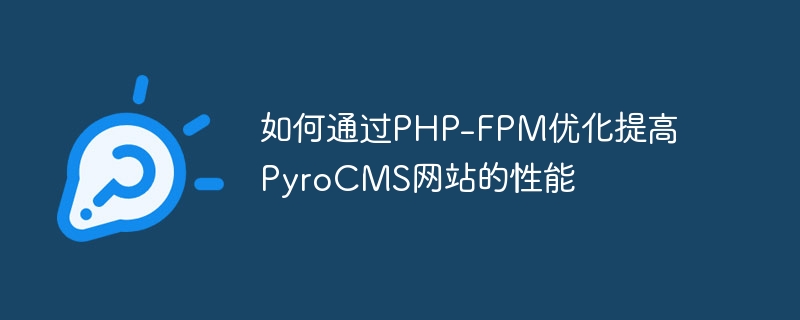

How to improve the performance of PyroCMS website through PHP-FPM optimization
With the rapid development of the Internet, the optimization of website performance has become more and more important. PyroCMS is a popular content management system that provides website managers with a powerful and flexible platform. However, as website traffic increases, PyroCMS may become sluggish and response times may become longer. In this article, we will introduce how to improve the performance of your PyroCMS website through PHP-FPM optimization.
PHP has some performance improvements and optimizations between different versions. Using the latest version of PHP will provide better performance and efficiency. At the same time, ensure that the OpCache module is enabled in the production environment, which can cache the compilation results of PHP scripts to avoid recompiling PHP scripts for each request.
PHP-FPM is a fast CGI process manager that can provide better performance and resource management. You can optimize the performance of your PyroCMS website by adjusting the configuration of PHP-FPM. The following are some common configuration optimization items:
Using PHP cache can reduce the execution time of PHP scripts, thereby improving the performance of the website. For example, you can use APC (Alternative PHP Cache) or OPcache to cache the compilation results of PHP scripts. In this way, when the same script is requested multiple times, the cached results can be used directly without recompiling the script.
The following is an example of using APC cache:
// 检查APC扩展是否加载 if (extension_loaded('apc')) { // 检查缓存是否存在 $cacheKey = 'your_cache_key'; $cachedData = apc_fetch($cacheKey); // 如果缓存不存在,执行逻辑并存入缓存 if ($cachedData === false) { $data = your_long_running_code(); apc_store($cacheKey, $data); } else { // 如果缓存存在,直接使用缓存的结果 $data = $cachedData; } // 输出数据 echo $data; } else { // 如果APC扩展未加载,执行原始逻辑 your_long_running_code(); }
Excessive database queries will cause low website performance One of the common reasons. You can use some optimization techniques to reduce the number of database queries and thereby improve website performance. The following are some feasible optimization strategies:
In addition to server-side optimization, front-end optimization is also an important part of improving website performance. Here are some front-end optimization suggestions:
To sum up, the performance of PyroCMS website can be improved through the optimization of PHP-FPM. By using the latest PHP version, adjusting the configuration of PHP-FPM, using PHP caching, reducing the number of database queries and performing front-end optimization, you can effectively improve the performance of the website and provide a better user experience. Although the above mentioned are some common optimization methods, the specific optimization strategy should be adjusted according to actual needs and server environment. I hope this article can help you optimize the performance of your PyroCMS website.
The above is the detailed content of How to improve the performance of PyroCMS website through PHP-FPM optimization. For more information, please follow other related articles on the PHP Chinese website!
 What are the differences between weblogic and tomcat
What are the differences between weblogic and tomcat How to delete ktpcntr.exe
How to delete ktpcntr.exe What are the common secondary developments in PHP?
What are the common secondary developments in PHP? Build an Internet server
Build an Internet server pscs5 installation serial number
pscs5 installation serial number Ubuntu startup black screen solution
Ubuntu startup black screen solution Introduction to the usage of vbs whole code
Introduction to the usage of vbs whole code The difference between mongodb and mysql
The difference between mongodb and mysql



